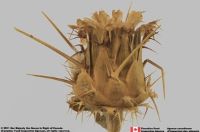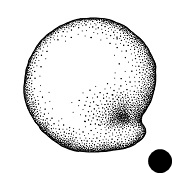Content is from Kirkbride et al. 2006Kirkbride et al. 2006:
Kirkbride JH, Jr, Gunn CR, and Dallwitz MJ. 2006. Family guide for fruits and seeds, vers. 1.0. Accessed September 2020-January 2022. URL: https://nt.ars-grin.gov/seedsfruits/keys/frsdfam/index.cfm ., without modification.
Updates are forthcoming.
Fruits: Pistil(s) simple; 1 to 2–5; 1–3-pistillate. Fruit anthocarpanthocarp:
simple or compound and including some tissue of non-ovarian origin (accessory tissue) ; simple; glans (from index in Spjut); without persistent central column; within accessory organ(s); within involucreinvolucre:
; simple; glans (from index in Spjut); without persistent central column; within accessory organ(s); within involucreinvolucre:
in the grasses, a whorl or cluster of bracts or bristles subtending a floret or spikelet , or cupule (shallow or more or less deep cupules are similar to but not the fused many bracts of Quercus, Fagaceae); accrescentaccrescent:
, or cupule (shallow or more or less deep cupules are similar to but not the fused many bracts of Quercus, Fagaceae); accrescentaccrescent:
growing continuously
; persistent; 1-seeded to more than 1 but less than 10-seeded; 1–3-seeded; less than 1 cm long to from 1–5 cm long; 0.5–1.1 cm long; with 1-carpellate; not sulcatesulcate:
surface relief—having one or more elongate, relatively narrow and shallow depressions or grooves ; apexapex:
; apexapex:
the point farthest from the point of attachment, or the "tip" of an organ not beaked; indehiscentindehiscent:
not beaked; indehiscentindehiscent:
not opening on its own, as in a fruit
 . Epicarpepicarp:
. Epicarpepicarp:
outer layer of fruit wall or pericarp, if divided into layers; note here used synonymously with exocarp dulldull:
dulldull:
reflecting only a low proportion of incident light, with no apparent sheen ; durable; glabrousglabrous:
; durable; glabrousglabrous:
without hairs
, or not glabrousglabrous:
without hairs
(with hairs); hairs very short (puberulentpuberulent:
surface relief—(or puberulous) bearing minute, soft hairs
); hairs scattered; hairs not glandularglandular:
surface relief—covered with small, raised secretory glands, regular or irregularly shaped, translucent or opaque, and maybe distinctly colored ; without armature; without wing(s), or with wing(s); 1–3-winged (central maybe 2-winged; laterallateral:
; without armature; without wing(s), or with wing(s); 1–3-winged (central maybe 2-winged; laterallateral:
(of embryo) embryo lies along the side of the seed, generally towards one end; of, at, or from the side; in grasses, can refer to the sides adjacent to the dorsal and ventral sides
maybe 2-winged); with wing(s) laterallateral:
(of embryo) embryo lies along the side of the seed, generally towards one end; of, at, or from the side; in grasses, can refer to the sides adjacent to the dorsal and ventral sides
; without apicalapical:
at or pertaining to the end of the seed or fruit distal from its point of attachment (i.e., base)
respiratory hole. Mesocarpmesocarp:
the middle layer of the pericarp, if divided into layers absent. Endocarpendocarp:
absent. Endocarpendocarp:
the inner layer of the pericarp, if divided into layers present; not separating from exocarpexocarp:
present; not separating from exocarpexocarp:
outer layer of fruit wall or pericarp, if divided into layers; note here used synonymously with epicarp ; thin; not splitting into 1-seeded pyrenes; without operculumoperculum:
; thin; not splitting into 1-seeded pyrenes; without operculumoperculum:
a dehiscent cap (or lid) of a seed or fruit that opens during germination or dehiscence ; without secretory cavities; without longitudinallongitudinal:
; without secretory cavities; without longitudinallongitudinal:
of or relating to length or the lengthwise dimension
ridges. Funiculusfuniculus:
(alt. funicle) stalk connecting the ovule (later seed) to the ovary (later fruit) placenta short; short without seed bearing hookswith hooks:
short; short without seed bearing hookswith hooks:
bristles or spines with curved or backwards pointing tips, or with secondary bristles along their length (retinacula); not persisting in fruit after seed shed.
(retinacula); not persisting in fruit after seed shed.
Seeds: Arilaril:
(broad sense) appendicular structure that wholly or partly envelops a seed and is produced from or a modification of the funicle, raphe, or outer integument; usually fleshy or pulpy, sometimes spongy or tufted-capillate, often brightly colored absent. Seed ovateovate:
absent. Seed ovateovate:
2D shape—egg-shaped in outline, widest point is towards one end of the organ, the other end tapers gradually, attachment at or near the broad end (compare obovate, ovoid) ; in transection flattened; not bowl shaped; not nutlike; without winglike beakbeak:
; in transection flattened; not bowl shaped; not nutlike; without winglike beakbeak:
a usually firm, terminal appendage, sometimes tapered ; without caudatecaudate:
; without caudatecaudate:
tapering to a long, tail-like appendage appendage(s); at maturity with food reserves, or without apparent food reserves; with endosperm; without canavanine. Sarcotestasarcotesta:
appendage(s); at maturity with food reserves, or without apparent food reserves; with endosperm; without canavanine. Sarcotestasarcotesta:
pulpy or fleshy outer layer of the seed coat, simulates aril absent. Testatesta:
absent. Testatesta:
seed coat
 present; without markedly different marginalmarginal:
present; without markedly different marginalmarginal:
at, on, or close to the margin or border
tissue; without fleshy or leatheryleathery:
texture—moderately thick, tough, and very pliable
layer over hard layer; without crease or line separating cotyledons from hypocotyl-radicle; without notch along margin where cotyledons from hypocotyl-radicle tip approach each other; without glands; without bristles; glabrousglabrous:
without hairs
; without wings; without collar; without operculumoperculum:
a dehiscent cap (or lid) of a seed or fruit that opens during germination or dehiscence ; colored; monochrome; membranousmembranous:
; colored; monochrome; membranousmembranous:
texture—extremely thin, pliable, and fairly tough
; not becoming mucilaginousmucilaginous:
resembling mucilage; moist and sticky
when wetted; surrounding embryo (based on family character). Embryo differentiated from food reserve; well developed; 1 per seed; completely filling testatesta:
seed coat
 (no food reserve); 1 times the length of food reserve; at one end of seed not extending into a depression or cup; without coleorhiza; without simmondsin; without stomata; not green; with 2 or more cotyledons. Cotyledons 2; well developed; not divaricate; somewhat to significantly wider than hypocotyl-radicle; thin; flat, or once-folded, or plicate, or crumpled; with apicesapex:
(no food reserve); 1 times the length of food reserve; at one end of seed not extending into a depression or cup; without coleorhiza; without simmondsin; without stomata; not green; with 2 or more cotyledons. Cotyledons 2; well developed; not divaricate; somewhat to significantly wider than hypocotyl-radicle; thin; flat, or once-folded, or plicate, or crumpled; with apicesapex:
the point farthest from the point of attachment, or the "tip" of an organ entire; equal in size; not punctatepunctate:
entire; equal in size; not punctatepunctate:
surface relief—dotted with pits or with translucent, sunken glands or with colored dots, similar to pitted dotted.
dotted.
 , partly to completely enclosed in incolucre". Cupule hardened in fruit, enclosing 1 to 3 nuts; ca. 5–7 mm, nutnut:
, partly to completely enclosed in incolucre". Cupule hardened in fruit, enclosing 1 to 3 nuts; ca. 5–7 mm, nutnut: 3 or 1 per "cup", cupule 2–4-partite valved. NutsNut:
3 or 1 per "cup", cupule 2–4-partite valved. NutsNut: flat, more or less orbicularorbicular:
flat, more or less orbicularorbicular: to ovateovate:
to ovateovate: , rarely lined with a thin margin, 1-seeded. Fruit with 1, 2-winged central nutnut:
, rarely lined with a thin margin, 1-seeded. Fruit with 1, 2-winged central nutnut: and 2, 3-winged laterallateral:
and 2, 3-winged laterallateral:Literature specific to this family: Prain, D. 1910. Bot. Mag. 136: Plate 8314; Correa, M.N. 1984. Flora Patagonica, Parte 4a. Collección Científica del Inta, Buenos Aires; Dimitri, M.J. & V.A. Milano. 1950. Las plantas cultivadas en la Republica Argentina: Fagaceas. Min. Agric. Ganad. 8:1–15; Soepadmo, E. 1972–75. Fagaceae. In: C.G.G.J. van Steenis, ed., Flora Malesiana, vol. 7, pp. 265–403. Wolpers-Noordhoff Publishers, Groningen.
General references: Extracted from Fagaceae Cronquist, A. 1981. An integrated system of classification of flowering plants, 1,262 p. Columbia University Press, New York, Flora of Australia (various years & volumes). Australian Government Publication, Canberra, Goldberg, A. 1986 (dicots) & 1989 (monocots). Classification, evolution, and phylogeny of the familes of Dicotyledons. Smithsonian Contr. Bot. 58 for dicots (314 pp.) & 71 for monocots (74 pp.). [Goldberg's illustrations are reproduced from older publications and these should be consulted], Gunn, C.R., J.H. Wiersema, C.A. Ritchie, & J.H. Kirkbride, Jr. 1992 & amendments. Families and genera of Spermatophytes recognized by the Agricultural Research Service. Techn. Bull. U.S.D.A. 1796:1–500, Mabberley, D.J. 1987. The plant-book, 706 p. Cambridge University Press, Cambridge, and Spjut, R.W. 1994. A systematic treatment of fruit types. Mem. New York Bot. Gard. 70:1–182.